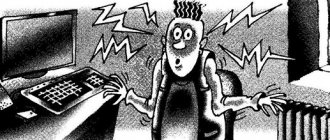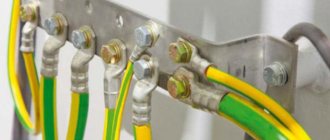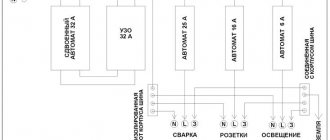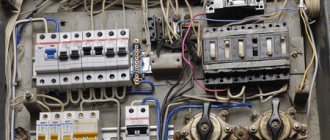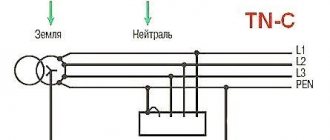High voltage protection is an integral part of the electrical network and is performed in various ways, one of which is grounding. According to the rules of the PUE, it is a mandatory component, but in many houses, especially older ones, it is still missing. To understand whether there is such protection in your apartment, you need to know how to check the grounding in the outlet, because all modern electrical appliances have contacts for it.
Why ground an electrical circuit?
Many ordinary people are stunned by the information that the neutral and grounding conductors in the socket can be connected to the same wire on the floor panel (or the main distribution panel of the house). A logical question arises: why pull the third wire if two of them are still connected to each other?
In practice, the fundamental principle applied here is that everything in nature moves along the path of least resistance from greater to lesser. Water flows from top to bottom, heat is transferred from a hot body to a cold one, and electric current flows to where the resistance of the conductors is less.
If a short circuit occurs in an electrical circuit without grounding, then the mechanism of its action is approximately the following:
- The current strength and voltage in the network increases abruptly tens of times.
- If the wiring is weak, it will burn out.
- If the wiring strand is of sufficient thickness (section) to withstand increased loads, it heats up, causing the insulation to ignite.
- Whether the wiring is burned out or not, if during a short circuit a person touches any metal part of the device, then he receives an electric shock, and its values are an order of magnitude higher than just in a socket. In the first case, this is a short-term shock, and in the second, until the current finds a weak point in the wiring and burns it, after which the circuit opens.
If there is grounding, then everything is not so sad:
- The current and voltage increase, but at the same time they immediately have “where to run” - the grounding wire.
- The natural resistance of the human body is much greater than that of copper, aluminum or steel, so even if a person holds on to the metal parts of the device, the current will simply “pass by” along an easier path. Hence, one of the requirements for grounding wiring is that it should be carried out, if possible, with one solid wire - twists are allowed on the floor panel, on the input circuit breaker, and then one solid core runs through the apartment.
On regular wiring there are automatic switches that trip if the load in the circuit exceeds permissible limits. During normal operation of the circuit, there should be no voltage at all on the grounding wire, so in conjunction with it it is logical to use an RCD that responds to leakage current, which is usually insignificant. As a result, in the event of a short circuit, the current is turned off immediately, and not due to melting of the wiring.
For more information about what happens when there is a short circuit in the circuit, watch this video:
The role of grounding in terms of electrical safety is discussed above, but it also serves to prevent electrical noise that can negatively affect the operation of computers and other delicate devices. Watch this video for more details:
Design of electrical sockets
The industry produces two types of products:
- equipped with a grounding bus;
- not having a grounding bus.
The first type of design is often called a “euro-socket”. This design fully satisfies electrical safety requirements.
The appearance of the electrical outlet according to the standards established by the European Union countries. A distinctive feature of the design is the presence of contact bimetallic grounding plates
The second type of product is considered an outdated modification, but is still found in practice. Especially many outdated sockets are used in old buildings.
Design option without specific country affiliation. For modern electricians, it is considered an outdated model, which is not recommended for installation due to increased danger due to the lack of a grounding contactor
Both types of products are made for indoor or outdoor installation. According to the new PEB recommendations, modifications of sockets for internal installation must have bimetallic plates with a grounding contactor as part of the design. For electrical sockets for external installation, the recommendations are the same, but in some cases of their use a two-wire interface is allowed.
Household methods for checking the presence of grounding
If it is clear why grounding is needed in an outlet, then the question remains of how to find out whether it works - after all, in practice, the zero in the network is always grounded and, in fact, the connection goes through the same wire. Here you need to understand that in some cases grounding is an additional zero, but if possible with less wire resistance. It is also necessary to take into account that the wiring in the apartment can be done correctly, but if there are no separate terminals for grounding on the access panel, then the wire may be left unconnected until a separate grounding bus is installed in the house.
For the simplest test, you need a voltage indicator or tester, a test light and a screwdriver.
Visual inspection
The first thing you need to look at is the design of the sockets in the house - they may only have two holes for a plug or with additional contacts.
In the first case, it is clear that the design of the sockets themselves does not provide for grounding. The second is that connecting protection to them is possible in principle, but whether it actually exists needs to be checked additionally.
Next, the outlet itself is disassembled - here you need to look at how many wires come out of the wall and what color they are. According to standards, the phase is connected with a brown (black, gray, white) wire, zero with blue, and grounding with two-color yellow-green. In older homes, this may simply be two or three wires of one color. If only two wires are used, then this clearly indicates a lack of grounding. If three wires come out, then additional testing will be required.
Additionally, you need to inspect the panel near the electric meter - if only two wires enter the apartment, this also indicates that there is no grounding initially.
Grounding in the absence of grounding
There is a possibility of detecting only two wires entering the apartment, but when inspecting the sockets, it is clear that the grounding contacts and the neutral wire are short-circuited with each other by a jumper. This connection option is called grounding, but its use is prohibited by the rules of the PUE, since in the event of a short circuit, the voltage immediately appears on the housings of the devices and there is a high probability of electric shock to a person.
Even without a short circuit, such a connection is dangerous in case of a fairly common breakdown - the neutral wire burns out on the input circuit breaker. In this case, the phase through the contacts of the devices ends up on the neutral wire, which, after a burnout, is not connected to ground. The voltage indicator will show the phase in all socket contacts.
About what grounding is and why it is dangerous, watch this video:
How to determine the presence of grounding
If three wires are brought out to the socket and they are all connected to it, you can check the functionality of the grounding with a tester or a regular light bulb.
To do this, you need to determine which wire the phase is on, which is done with a voltage indicator. Moreover, if a phase is detected on two wires, then the network is faulty.
When a phase is found, the light bulb is touched with one wire, and the second is alternately touched to zero and ground. When you touch the neutral wire, the light bulb should light up, but whether there is grounding, you need to look at its behavior - the following options are possible:
- The light does not light up. This means that there is no grounding - most likely, the wire is not connected anywhere in the distribution panel.
- The light bulb glows exactly the same as when connected to the neutral wire. This means there is grounding and in the event of a short circuit the current will have somewhere to go, but there is no protection that responds to leakage current.
- The light bulb begins to glow (in some cases it does not have time to light up), but immediately the electricity in the entire apartment turns off. This means that the grounding is connected and working correctly - there is an RCD on the input panel of the apartment that cuts off the voltage when a leakage current occurs, which goes to the grounding wire.
When checking, you need to pay attention to the brightness of the light bulb or what values the voltmeter shows. If, compared to the connection to the neutral wire, the light bulb glows dimmer (or the voltage is lower), then the resistance of the ground wire is higher and its efficiency is low.
Correct connection
To carry out grounding in an old apartment building in accordance with current requirements, it is necessary, first of all, to change the two-wire wiring to three-wire (along with the phase and neutral wires, there must be a PE grounding wire). To install new wiring, it is important to use a high-quality three-core cable, for example, VVG or NUM.
It is best to ground a multi-storey residential building not with a separate apartment, but together with other residents. This will significantly reduce costs for each individual resident. If necessary, the installation of a grounding loop for an apartment building should be agreed upon with the management company. It is recommended to install the circuit itself not along the facade, but along the back side of the building. The grounding conductor is routed throughout the apartments and connected in the panels using a copper busbar. The size of its cross-section must be no less than the cross-section of the PEN core in the cable supplied to the input distribution device of the house.
Complete grounding check
In fact, even the presence of grounding in an apartment does not guarantee its correct operation. For a complete check, it is necessary to carry out a series of measurements of the resistance of the conductors to make sure that the grounding wire is indeed a “convenient” path for electric current and that during a short circuit it will flow in the desired direction.
It is almost impossible to carry out such a test at home, since it requires sensitive instruments. In addition, it is necessary to measure the resistance of the conductors not only in relation to each other, but also to the ground. If you are curious how this is done, take a look here:
As a result, if grounding is needed not only to protect a person from electric shock, but also to ensure the clean operation of sensitive devices (for example, in sound recording), it is advisable to contact specialists for verification. Otherwise, it is enough that when a leakage current appears on the grounding conductor, the RCD circuit breaker is triggered.
Checking with a multimeter
After opening the socket, there were three wires in it, and even the color standards were met. It is necessary to find out whether there is grounding, that is, whether it works. How it's done.
- The power supply to the apartment or house is turned on in the panel.
- The device switches to voltage test mode.
- One probe is set to phase, the second to zero. The voltage is measured.
- Now the probe from zero needs to be moved to PE. If in such a position a value is shown that is equal to or slightly less than the previous indicator, then the PE circuit is working. If the indicator board on the measuring device showed “zero” or the numbers did not appear at all, then a break occurred somewhere. That is, the grounding system in the apartment does not work.
How to find out if there is grounding in an outlet?
In order for modern equipment in the house to function safely and smoothly, you should check the grounding in the sockets.
Especially when a person moves to a new home, it is imperative to check the correct connection of the ground contact in all sockets. Sometimes we don't even realize that the grounding socket is not even connected. Therefore, the question “how to check the grounding in an outlet?” very relevant today. You can call an electrician to check, but if this is not possible, you can do it yourself.
Conclusions and useful video on the topic
You can familiarize yourself with the nuances of installing a grounded outlet using the video:
By the way, it will be noted: if there is a grounding bus in the sockets, the degree of reliability of household appliances increases. Digital equipment reacts especially critically to the lack of “ground”, and such equipment is now present everywhere.
Tell us what method you use to check grounding in sockets. Share your own skills with readers, participate in discussions and ask questions. The comment box is located below.



